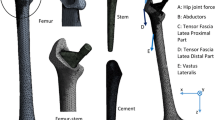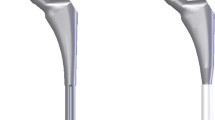Abstract
The quality of cementation is of paramount importance for the long-term clinical outcome in cemented total hip replacement. Four “modes of failure” have been differentiated by various authors and correlated with the clinical findings. A finite element analysis was performed to simulate an ideally cemented femoral stem-type prosthesis as well as failure modes III (proximal anchorage of implant only) and IV (Distal anchorage of implant only). While failure mode III produces a stress distribution at the bone/acrylic cement interface, which is similar to the ideally cemented prosthesis, failure mode type IV leads to a hazardous rise of the interface stresses. This correlates well with the clinical findings given in the literature, thus validating the computer simulation used. Distal cementation only of a stem-type femoral component in total hip replacement should definitely be avoided.
Similar content being viewed by others
References
Bannister G (1988) Mechanical failure in the femoral component in total hip replacement. Orthop Clin North Am 19:567–573
Beckenbaugh RS, Ilstrup DM (1976) Total hip arthroplasty: a revision of 333 cases with long-term follow-up. J Bone Joint Surg [Am] 60:306
Cameron HU, McNeice GM (1980) A correlation of radiographic “modes of failure” with clinical failure of cemented stem-type femoral components. Clin Orthop 150:154–158
Carter DR, Orr TE, Fyhrie DP (1989) Relationship between loading history and femoral cancellous bone architecture. J Biomech 22:231–244
Cochran GB van (1988) Orthopädische Biomechanik. Enke, Stuttgart
Cotteril P, Hunter GA, Tile M (1982) A radiographic analysis of 166 Charnley-Müller total hip arthroplasties. Clin Orthop 163:120–126
Cowin CS (1986) Wolff's Law of trabecular architecture at remodeling equilibrium. J Biomech Eng 108:83–88
Fyhrie DP, Carter DR, Schurman DJ (1988) Effects of ingrowth, geometry, and material on stress transfer under porouscoated hip surface replacements. J Orthop Res 6:425–433
Gruen TA, McNeice GM, Anstutz HC (1979) “Modes of failure” of cemented stem-type femoral components. A radiographic analysis of loosening. Clin Orthop 141:17–27
Harrigan TP, Harris WH (1991) A three-dimensional nonlinear finite element study of the effect of cement-prosthesis debonding in cemented femoral total hip components. J Biomech 24:1047–1058
Heimkes B, Posel P, Plitz W, Jansson V (1993) Forces Acting on the Juvenile Hip Joint in the One-legged Stance. J Pediatr Orhtop 13:431–436
Huiskes P (1990) Comparative stress patterns in cemented total hip arthroplasty. Orthop Relat Sci 1:93–108
Huiskes R, Boeklagen R (1989) Mathematical shape optimization of hip prosthesis design. J Biomech 22:793–804
Huiskes R, Weinans H, Grootenboer HJ, Dalstra M, Fudala B, Sloff TJ (1987) Adaptive bone-remodeling theory applied to prosthetic-design analysis. J Biomech 20:1135–1150
Kummer B (1981) Kraftfluß Prothese-Femur. Anpassungs- und Überlastungsreaktionen des Knochens. In: van Maaz B, Menge M (eds) Aktueller Stand der zementfreien Hüftendoprothetik. Thieme, Stuttgart
McNeice GM, Gruen TA (1976) Mechanical failure modes for femoral components of total hip replacement. Trans Orthop Res Soc New Orleans 1:172
Merck E (1989) Refobacin-Palacos R. Informationsschrift zum Knochenzement Palacos R. Merck, Darmstadt
Pauwels F (1973) Atlas zur Biomechanik der gesunden und kranken Hüften. Springer, Berlin Heidelberg New York
Poss R, Brick GW, Wright RJ, Roberts DW, Sledge CB (1988) The effects of modern cementing techniques on the longevity of total hip arthroplasty. Orthop Clin North Am 19:591–598
Rohlmann A, Moessner U, Bergmann G, Koelbel R (1987) Effects of stem design and material properties on stress in hip endoprostheses. J Biomed Eng 9:77–84
Author information
Authors and Affiliations
Rights and permissions
About this article
Cite this article
Jansson, V., Refior, H.J. Mechanical failure of the femoral component in cemented total hip replacement — a finite element evaluation. Arch Orthop Trauma Surg 113, 23–27 (1993). https://doi.org/10.1007/BF00440590
Received:
Issue Date:
DOI: https://doi.org/10.1007/BF00440590




